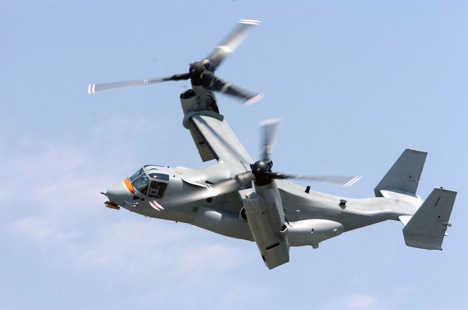
Building unmanned tilt-rotor aircraft has been a recurrent theme in recent years.
Press PhotoAt the MAKS-2015 exhibition, Russian Helicopters show-cased a new multi-purpose unmanned aircraft with tilting rotors, building on past Soviet experience.
Soviet engineers began work on the Mi-30 project in the early 1970s. The aircraft was designed for a load-carrying capacity of 5 tons, and included in the programme called Weapons Development from 1986 to 1995. Beset with financial troubles, however, the project did not take off beyond the R&D stage.
Russian Helicopters is currently working on refining these critical technologies, the company press release said. A whole range of aircraft, both piloted and unmanned, are planned, based on this research. Details of the project have not been disclosed.
The only serially produced tilt-rotor is the American Bell V-22 Osprey, which first took flight in 1989, but came into regular operation only in 2005. These aircraft are piloted and used as military transport planes, in anti-submarine operations, as well as for search and rescue missions.
Another tilt-rotor design was also displayed MAKS. The Kronstadt Group of Companies (aviation division, created after reorganization of the Transas Group) showed their high-speed unmanned aerial vehicle (UAV), called ‘Frigate’, which could also be considered a tilt-rotor, because of its tilting engines. The Frigate’s builders say this aircraft would be able to vertically take-off and land, as well as take off and land like a regular airplane. The vertical take- off and landing facility works well where there are no regular helipads and airstrips. The Frigate can carry loads from 1 ton (helicopter-style takeoff) to 1.7 tons (regular airplane-style takeoff) and stay aloft for up to 10 hours. It can to attain speeds that are impossible for modern helicopters, of between 600 and 700 kms/h. The ‘Frigate’ has been designed for aerial surveillance and to transport cargo.
Kronstadt representatives said serial production of the Frigate would begin by 2022, and financing would be provided by the Advanced Research Foundation (ARF) and the Bank for Development and Foreign Economic Affairs (VEB).
Building unmanned tilt-rotor aircraft has been a recurrent theme in recent years. Earlier, in February 2015, test flights of the Russian UAV Era-50, built as a tilt-rotor aircraft, have started.
According to Eduard Razroev, representative of the Kazan company Aeroks, which designed and developed the Era-50, by using the tilt-rotor aerodynamic configuration, they have managed to abandon the need for mechanization of the wing and tail components.
The Era-50 UAV weighs 5 kg and can carry up to half a kilogram of payload. Its “big brother”, the Era-100, which they will begin testing in a few months, will weigh 20 kg and lift a 2.5-kg payload. Both are tilt-rotors, able to perform vertical take-offs and landings, attain high-speeds during horizontal flight, and hover over any desired point.
At the Aeroks Company, they have noted that potential buyers of this new technology could be civilian and military entities, with which preliminary agreements have been signed.
All rights reserved by Rossiyskaya Gazeta.
Subscribe
to our newsletter!
Get the week's best stories straight to your inbox